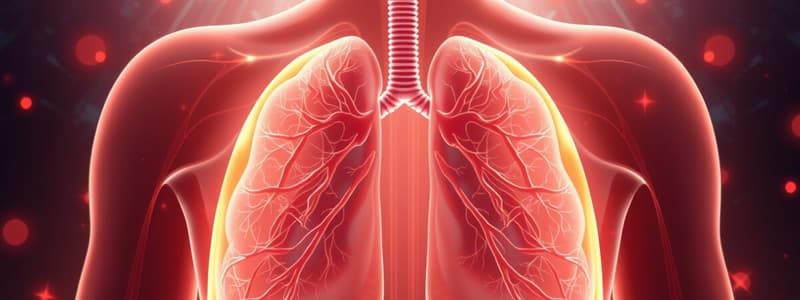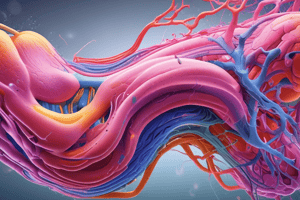Podcast
Questions and Answers
What type of chemoreceptors are located in the carotid bodies?
What type of chemoreceptors are located in the carotid bodies?
- Tissue chemoreceptors
- Global chemoreceptors
- Central chemoreceptors
- Peripheral chemoreceptors (correct)
Which area of the brain contains the central chemoreceptors?
Which area of the brain contains the central chemoreceptors?
- Cerebral cortex
- Cerebellum
- Medulla (correct)
- Pons
What is the primary chemical composition change that central chemoreceptors respond to?
What is the primary chemical composition change that central chemoreceptors respond to?
- Increased PO2 levels
- Decreased oxygen content
- Increased PCO2 levels (correct)
- Decreased pH levels
Where are peripheral chemoreceptors primarily located?
Where are peripheral chemoreceptors primarily located?
What role does the fourth ventricle play in relation to the brainstem and cerebellum?
What role does the fourth ventricle play in relation to the brainstem and cerebellum?
What is the primary location of the pneumotaxic center?
What is the primary location of the pneumotaxic center?
Which chemical component primarily regulates ventilation in the body?
Which chemical component primarily regulates ventilation in the body?
Which structure is primarily responsible for the voluntary control of breathing?
Which structure is primarily responsible for the voluntary control of breathing?
What function does the respiratory control center mainly serve?
What function does the respiratory control center mainly serve?
What does the term 'afferent information' refer to in the context of peripheral chemoreceptors?
What does the term 'afferent information' refer to in the context of peripheral chemoreceptors?
Which statement about central chemoreceptors is incorrect?
Which statement about central chemoreceptors is incorrect?
Which group consists of the nucleus tractus solitarius?
Which group consists of the nucleus tractus solitarius?
The primary role of the pneumotaxic center is to:
The primary role of the pneumotaxic center is to:
What do the neurons in the ventral respiratory group mainly contribute to?
What do the neurons in the ventral respiratory group mainly contribute to?
Which area is NOT mentioned as a major site for ventilatory control?
Which area is NOT mentioned as a major site for ventilatory control?
Which of the following statements about the respiratory control center is true?
Which of the following statements about the respiratory control center is true?
What is the primary factor in the control of ventilation under normal sleep conditions?
What is the primary factor in the control of ventilation under normal sleep conditions?
Which type of sleep apnea is most common and occurs due to obstruction of the upper airway?
Which type of sleep apnea is most common and occurs due to obstruction of the upper airway?
Which condition would NOT reduce the response to arterial PCO2 levels during sleep?
Which condition would NOT reduce the response to arterial PCO2 levels during sleep?
What happens to arterial PCO2 levels during hyperventilation?
What happens to arterial PCO2 levels during hyperventilation?
What effect does lowered arterial PO2 have on the response to PCO2?
What effect does lowered arterial PO2 have on the response to PCO2?
Which factors contribute to the response of ventilation under normal conditions?
Which factors contribute to the response of ventilation under normal conditions?
Which center is primarily associated with the initiation of inspiration?
Which center is primarily associated with the initiation of inspiration?
What type of receptors are involved in relaying afferent inputs from airways and lungs?
What type of receptors are involved in relaying afferent inputs from airways and lungs?
How does the ventilation response in a normal awake individual behave as PaCO2 exceeds 40 mm Hg?
How does the ventilation response in a normal awake individual behave as PaCO2 exceeds 40 mm Hg?
What condition is characterized by prolonged cessation of airflow due to airway obstruction during sleep?
What condition is characterized by prolonged cessation of airflow due to airway obstruction during sleep?
Which part of the nervous system is the Medullary Respiratory Center associated with?
Which part of the nervous system is the Medullary Respiratory Center associated with?
Which receptors function as a breathing pacemaker?
Which receptors function as a breathing pacemaker?
What is the primary role of the Pneumotaxic Center?
What is the primary role of the Pneumotaxic Center?
Which cranial nerves provide sensory input to the Medullary Respiratory Center?
Which cranial nerves provide sensory input to the Medullary Respiratory Center?
What are the key components of the Respiratory Control Center?
What are the key components of the Respiratory Control Center?
Which group of neurons is specifically associated with inspiratory control?
Which group of neurons is specifically associated with inspiratory control?
What happens to tidal volume when sensory input from lung receptors is removed?
What happens to tidal volume when sensory input from lung receptors is removed?
What characterizes apneustic breathing?
What characterizes apneustic breathing?
What is primarily influenced by an increase in PaCO2 in the blood?
What is primarily influenced by an increase in PaCO2 in the blood?
Which specialized tissues respond to changes in chemical composition of the blood?
Which specialized tissues respond to changes in chemical composition of the blood?
What is NOT a component of the ventilatory control system?
What is NOT a component of the ventilatory control system?
Which response is typically a primary factor affecting ventilation?
Which response is typically a primary factor affecting ventilation?
What is the main effect of eliminating input from the cerebral cortex and thalamus, along with vagal blockade?
What is the main effect of eliminating input from the cerebral cortex and thalamus, along with vagal blockade?
What effect does vagal blockade have on respiration?
What effect does vagal blockade have on respiration?
Flashcards are hidden until you start studying
Study Notes
Major Sites of Ventilatory Control
- Medullary respiratory center is located in the medulla oblongata and is vital for regulating breathing.
- Central controllers include the medulla and the pons, influencing respiratory rhythm.
- Dorsal respiratory group (DRG) is associated with inspiration and consists of the nucleus tractus solitarius.
- Ventral respiratory group (VRG) includes nuclei regulating both inspiration and expiration.
- Pneumotaxic center in the upper pons inhibits inspiration, thus modulating inspiratory volume and respiratory rate.
- Apneustic center promotes prolonged inspiration.
Chemoreceptors
- Central chemoreceptors detect PCO2 levels and pH changes in extracellular fluid, located beneath the medulla.
- Peripheral chemoreceptors are found in the carotid (carotid bodies) and aortic arteries, responding to changes in blood oxygen (PaO2), carbon dioxide (PaCO2), and pH.
- Carotid and aortic bodies provide afferent signals to the central respiratory control center.
Response to CO2
- Arterial PCO2 significantly impacts ventilation control, with a linear rise affecting breathing patterns.
- Hyperventilation decreases PaCO2, while apnea can lead to elevated PCO2 levels.
- Central chemoreceptors primarily drive the stimuli for ventilation, but peripheral receptors react faster to oxygen level changes.
Sleep Apnea Syndromes
- Obstructive sleep apnea (OSA) is the most common, characterized by airway obstruction due to upper airway collapse during sleep.
- Contributing factors include age, genetics, and increased work of breathing.
Ventilatory Patterns
- Cheyne-Stokes ventilation involves a cyclical pattern of increasing and decreasing tidal volumes, often seen in various health conditions.
- Apneustic breathing features prolonged inhalation followed by short expirations.
- Input from lung receptors modulates breath length and volume, affecting overall ventilation.
Key Points to Remember
- Ventilatory control involves respiratory centers and various receptors.
- Central and peripheral chemoreceptors play crucial roles in responding to changes in blood gases.
- PaCO2 is the major determinant of ventilation under typical physiological conditions.
Studying That Suits You
Use AI to generate personalized quizzes and flashcards to suit your learning preferences.




